This article is part of my ongoing “Indie Fighting Game Thursday” review/retrospective series, now on supercombo.gg! This week we talk about Ultra Fight Da! Kyanta 2, a crazy 2D pixel art team fighter available for free on Steam! This article was originally published on my Medium blog on the 2nd September, 2021, and has been ported to Supercombo.gg for preservation and sharing it with more people in the fighting game community!
Some time ago, on Twitter, one could stumble across an account called Fighting Game Ideas. While it has been almost dormant for the past two years, it used to publish “totally-not-flawed” silly concepts for moves and mechanics in fighting games, including (and I cite it verbatim) “a character with an EWGF. if you miss the just frame version, he electrocutes himself and dies instantly.”
I genuinely liked that gimmick account — heck, almost by chance it gave me a rather brilliant idea on how to solve the “players who want everything from the get-go vs players who want to unlock stuff” conundrum in Schwarzerblitz! — and used to log in often to see what they were cooking.
One day, I stumbled upon this thread of theirs: “This whole game is a good fighting game idea. Try it out. It’s free.”
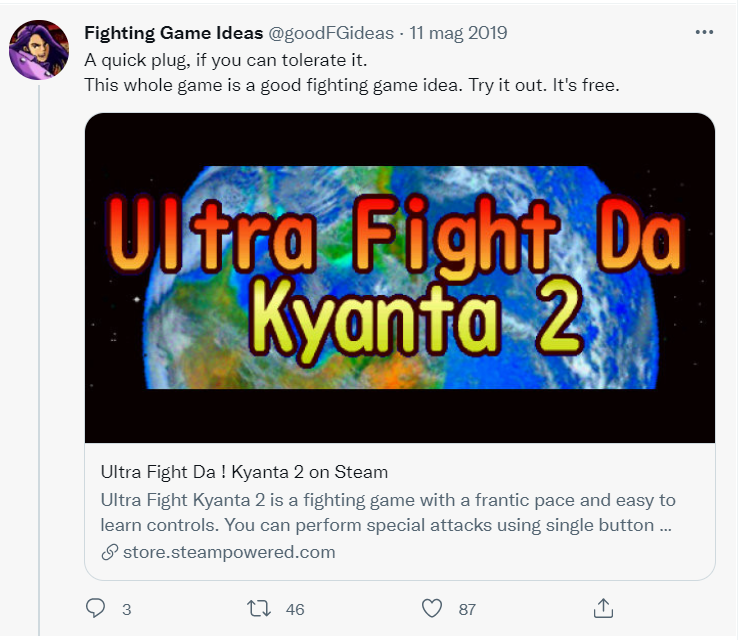
My first experience with “Ultra Fight Da! Kyanta 2″ was a Twitter thread by a gimmick account. No regrets.
The thread went to talk about this Japanese fighting game, called Ultra Fight Da! Kyanta 2, available on Steam for free, which showed a whole lot of peculiar design choices, including:
- no colliders: The character can walk through each other;
- no whiff animation for the standard throw, which comes out automatically if the player kept Light + Heavy pressed while approaching the opponent;
- the guard bar and the stun bar are unified in one bar called Boko bar;
- infinite input buffer: if you keep a button pressed during a move, the new move associated to that button will come out as soon as possible;
- there is a super meter bonus if a move is performed when the EX indicator flashes, which happens around every two seconds;
- … aaaaannd much more.
Given the premise, how could I, yet another wannabe fighting game developer, not want to check it out?! So, I took a deep breath and dove into this chaotic, beautiful mess, a Japanese fighting game like no other, brought to this world by the solo developer Kasubisha (here’s his personal website too).
And, if you are wondering “If this is Kyanta 2, where’s Kyanta 1?” the answer is simple: Kyanta 1 is not really a fighting game — rather, it’s a top-down up-to-4-players shooting game featuring the titular pomerianian and some other characters that made the jump to Kyanta 2. For those curious (or crazy) enough to try it out, it can be downloaded for free here.
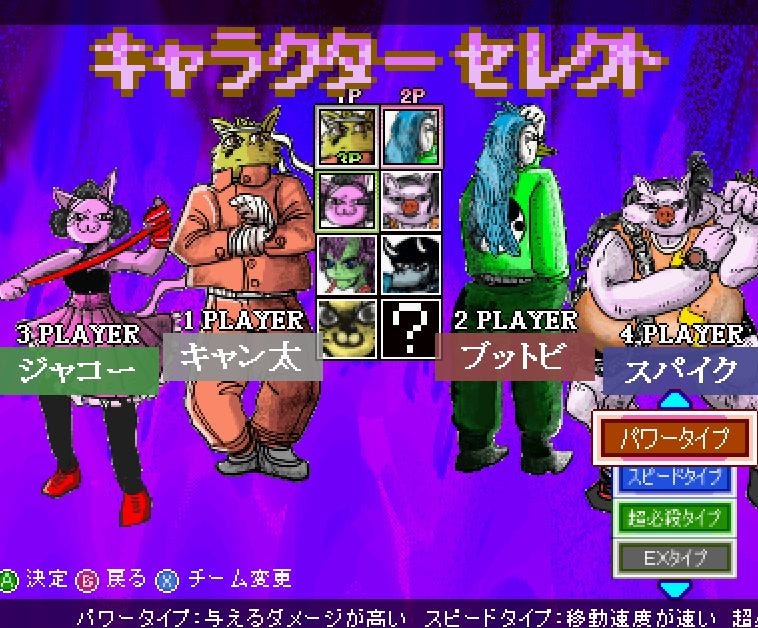
The roster of Kyanta 1, a top-down predecessor to the chaotic Kyanta 2.
King of the Kyantas

Choose your character! As a trivia, the top left character, Zacky Wild, is modelled and named after a real-life prominent Japanese player. Anyway, among 29 characters, there’s a lot of colorful choices, so it cannot be that hard to pick one and start fighting, right?
The first impact with Kyanta is rather overwhelming. You are hit by this very quirky aesthetic that seems right out of some ’90s webpage, with several different clashing art styles, hand-drawn anthropomorphic characters, high-pitched sound effects, obnoxious music and epilepsy-inducing flashes (to the developer’s credit, he later added a toggle to switch them off, making the game much more accessible, even for people with hypersensitivity).
When selecting arcade mode, you are welcomed by a first, Skullgirls-like choice, of how many character you want in your team (1 to 3). This affects the individual health values of each character, with solo characters having roughly as much health as a three-character team.
Once the number of characters is set, you will be able to choose a fighting style for each character, which — when not having the slightest idea of what you are doing — proves a little bit hard to do effectively.
Then, if your current style allows for it, you can also select one Ultra EX move among two different ones.
Finally, after selecting the color, you can move to the next character, until your team is complete. If you felt a bit lost the first time you went through this, you are not alone. But enduring this small step is the gateway to something worth the effort.
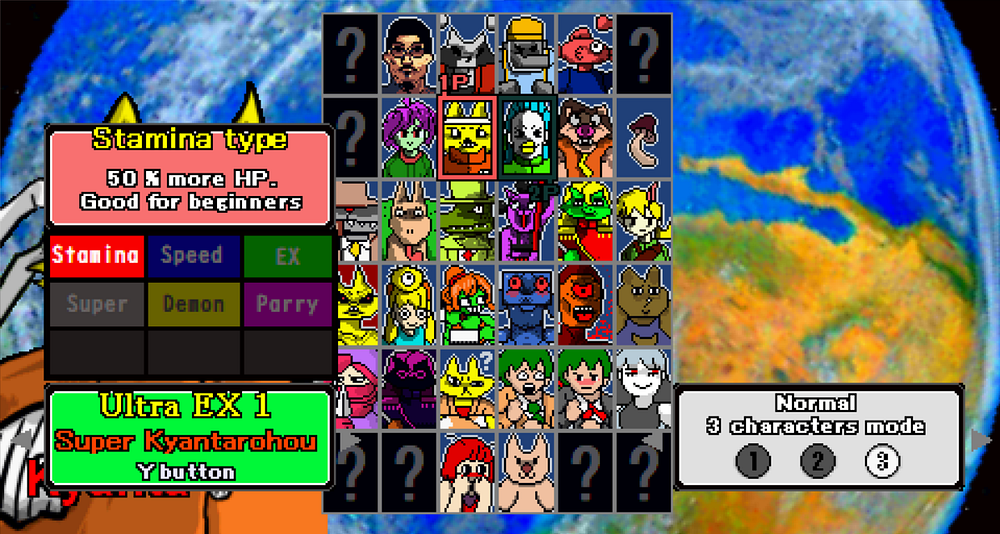
Oh, huh, nevermind — character selection MIGHT be a bit overwhelming for someone completely new to the game, as the number of choices required is significantly high. Number of characters in the team, style, one Ultra EX move among two (when available), and color must be all chosen before a match can begin.
Layers of subsystems
While the first impact might be disheartening, at its core Kyanta 2 is a game which fits the “easy to pick up, very hard to master” concept. There are no motions, all moves are performed by simply pressing a direction plus an input. There are four main buttons — Light, Heavy, Special and Ultra. The game is link based, but thanks to the generous input buffer, you can just keep a button pressed to make the move associated with it come out at the first available frame, greatly simplifying combo execution.
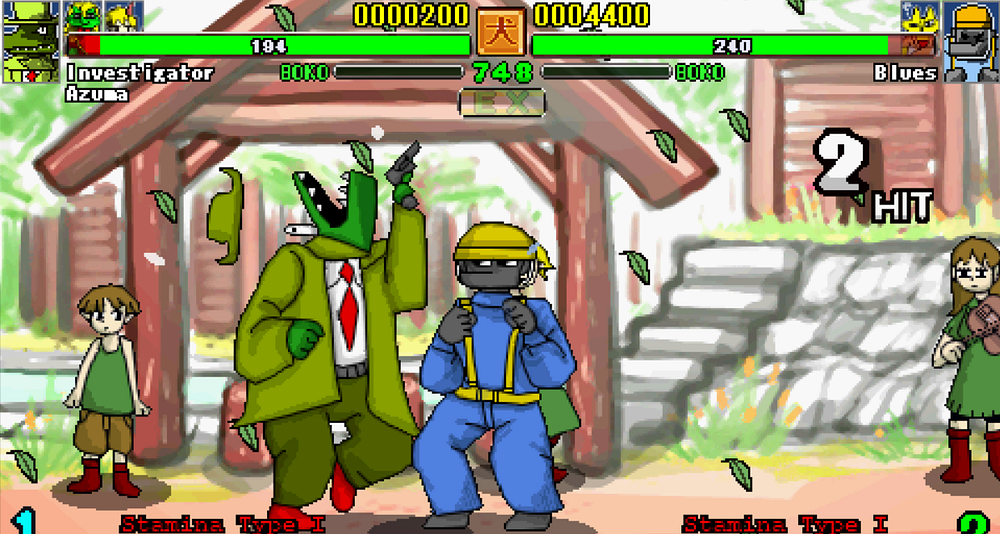
The stages are positively colorful and feel alive, with tons of secondary characters moving in the background. Also, Azuma’s face when hit is positively hilarious.
Most specials have an EX version that costs 1/2 super bar and can be performed by pressing Special plus Ultra at the same time. There is a handy assignable macro for this in the controller setting options.
By pressing Light plus Heavy or pressing Heavy when the characters are almost overlapped, you can perform a grab. The grab macro doesn’t have a whiff animation and triggers automatically when moving into the grab range, if the button is still kept pressed down.
By pressing Ultra plus Heavy, one can perform a “Kyanta Cancel”, which costs one meter and is functionally equivalent to a roman cancel, but has also the effect of increasing the damage dealt after the cancel by a flat 20 points. This too can be assigned to a single button, as a macro.
Specials and Ultra EXs do not deal chip damage, relieving a bit of pressure from the players who find themselves in the unenviable position of having to defend against walk-through crossups.
There’s a parry system too, similar to the one present in Street Fighter 3, where tapping forward or down (not down-forward!) can be used in lieu of blocking, in order to achieve the maximum advantage possible on a successful read. It comes with a huge risk, however, as you are completely open if you miss the timing.
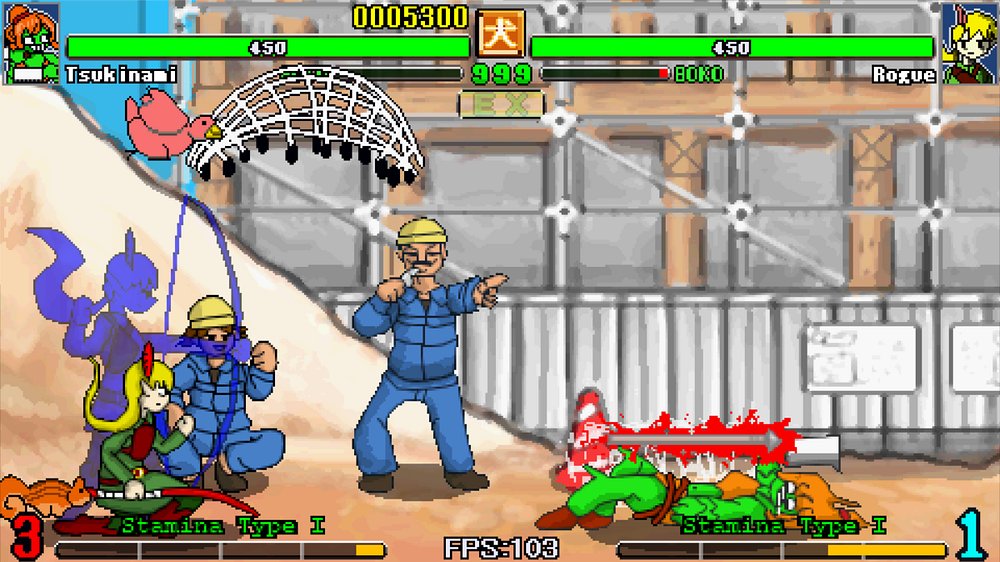
The game has a handy benchmark tool which can be used to see how smooth it can run on your PC. Surprisingly, it can run very well on potato PCs, but struggle on more modern gaming rigs, probably due to some idiosyncrasies of the Clickteam Fusion engine.
Bokoboko, Flash Bonus and other amenities
The flow of the matches reminds of “The King of the Fighters”, with teams of characters facing against each other, one after another in a sequence decided before the match starts — except much, much faster and more chaotic. Team size doesn’t affect only the health values: When a character is KO’d, the team they belonged to gains 1 bar of super meter. To offset this, the smaller the team, the faster the meter gain and the amount of super meter available at startup, giving solos and duos a fighting chance against trios.
In addition to all of the above, there are some interesting interactions one has to be aware of. For starters, the guard and the stun gauge are unified as the Boko gauge. If this gauge is depleted, the defending character will enter a dizzy state and receive extra damage.
There’s also another (quite hard to predict) Flash Bonus mechanics that adds bonus meter if a hit connects in a short time window while the EX indicator in the HUD blinks. Since I’m not an expert in its usage, I leave it to the competitive player YFDHippo, organizing the Saturday Morning Kyanta Fight Club weeklies, to describe it:
“So one of the things Ilike about Kyanta, is the hidden complexity of it.
It seems just chock full of mechanics, that — at first glance — you’d be surprised at how well they mesh.
The Flash Bonus indicator blinks when nobody is getting hit, around once per second. Very rarely, you are able to combo and also get a Flash Bonus, because there’s usually not enough time, even off a successful anti-air, and this is the neat part, either by design or accident.
The Flash Bonus internal clock keeps on running if nobody has been hit, and it is always running, even during a Kyanta Cancel or while the screen freezes when an Ultra is used. The time spent in those freeze-states is accrued to the Flash Bonus. There’s not a lot of natural Flash Bonus combos, but the game is filled with combos were you can hit, Kyanta Cancel, hit again, and get the Flash Bonus, essentially opening up combo routes that promote stricter timing, in order to get meter back while performing them.
Not only that: Because of the +20 flat damage bonus with each Kyanta Cancel, it sort of evens out damage on characters that otherwise have bad moves/ultras.
The cheap characters are still cheap and can do this as well, but it at least makes the worst characters dangerous with enough meter.
Even stranger, grabs do not reset the Flash Bonus check, so with enough practice, I think a decent chunk of the cast can also get a Flash Bonus off a throw, if people know the precise timing of the throw animations and when Flash Bonus was last active. Anyway, Flash Bonus is neat, I always thought it was a throwaway mechanic until like a year into the game.”

Even if not all characters have them already, Kyanta boasts a fair amount of combo trials. Also, I noticed that Chihiro has two right hands (or two left hands, depending on the side). Mystery of genetics!
A style for every season
As mentioned before, there are several available fighting styles (called “types”) that can be selected independently for each character. Each style is designed to adapt to different ways to express the character, and can change the way to approach a match quite a lot. Here’s the six types you can choose from:
- Stamina: 50% bonus health;
- Speed: increase movement speed;
- EX: reduced meter use for Ultra moves;
- Super: has both the advantages of Stamina and Speed, but without access to any Ultra moves;
- Demon: by pressing the Ultra button, the character will be able to perform EX moves for very little meter, for a short amount of time
- Parry: successful parries refill health and meter, but you cannot block.
Since each character in a team can be assigned a different style, one can build and experiment with various formations and try out several possibilities before settling on one setup. Stamina, for example, is the perfect choice for beginners, while Parry is the perfect choice for those who want to live on the edge, and treat each match as if they had to re-enact Evo Moment 37. There’s a sliding scale of risk vs. reward and it’s up to the player to choose how much they want to wager. Character whose gameplan doesn’t revolve around their Ultras might want to select Super and use meter for EX, for example, while characters who instead focus on Ultras (like Detective Azuma) might want to select EX as a style.
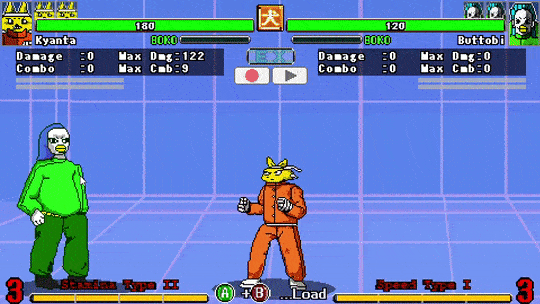
Combos can deal absurd levels of damage, especially if the opponent isn’t using Stamina Type. Also, crouching characters are dealt more damage than standing ones, which can lead to exclusive touch-of-death combos that are normally not possible.
Loads and loads of characters
When talking about Kyanta, one has to consider that the game has well 29 (!) playable characters, ranging from shotos like Kyanta and Gyanta (who has the equivalent of Akuma’s Shun Goku Satsu) to grapplers like Cocorn and Chihiro, setup characters like Tsukinami, and zoners like Rogue and Well Done. There is a lot of choice and the combination between types, selectable Ultras and team sizes work together in creating something that allows for a lot of experimentation.
Some characters that can be considered scrub killers (e.g. Taro and Well Done, which made my arcade runs very miserable) are actually pretty bad, competitively speaking, so don’t be fooled by the AI and try out everything you can before settling on one specific character!
There’s a handy page on Mizuumi detailing some basics for all of them, so in case of need, information is just a link away.

The game also offers a Parry Training minigame, featuring the cute Kinoko throwing mushrooms at you. And remember: You, me, everything is Kinoko!
A complete package
Aside from its local versus mode, Kyanta 2 offers a variety of options, including a classic arcade mode, culminating in a rather epic fight against a giant Robo Azuma (let it be set in stone that I hate that drill attack, dammit!) – or, if you never lose a round, with the dreaded Akuma-expy Shin Gyanta. This evil Pomeranian is — for all intent and purposes — an extremely broken version of regular Gyanta, with massively increased health and damage, and the de-facto most difficult AI opponent arcade mode will throw against you. I needed around 18 attempts before beating him, abusing the everlasting sheep out of Kyanta’s invincible dragon punch.
The game offers also a parry training minigame featuring Kinoko, a full on gallery with fan-arts sent by players around the world, and what amounts to the beginning of a story mode. Only the first chapter has been released in English for now, and deals with Masao, Kyanta’s human pupil, being turned into a girl by Well Done’s gender-change beam. The rest of the story is not available yet, but I think we can expect some layer of moody craziness with some unexpectedly mature themes sprayed in-between.
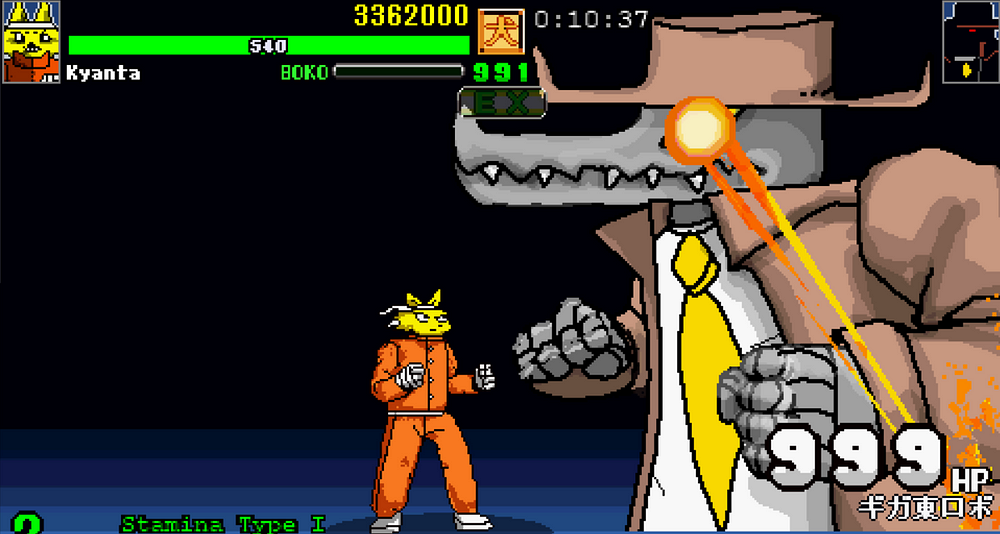
Giant Robo Azuma at the end of arcade mode is pretty intimidating. DON’T LET HIM START THE DRILLING LOOP!
For better or worse, Kyanta is a unique experience. One can genuinely see the love and passion of the developer for the fighting game genre, but, sometimes, Kyanta feels like a weird derelict of the ’90s doujin scene, resurfacing in an anachronistic way — with bright colours, jarring sound effects, flashy MS Paint-like graphics and some weird design choices that will make your brain squint its neurons to understand what the heck is actually happening on screen. That said, this game is a one-of-a-kind, and deserves a honest attempt at playing, if only for its freshness and genuine commitment at being its own thing.
How to play it?
Kyanta 2 is available free of charge on Steam and runs on Windows PCs. It has a functional delay-netcode (which is currently being upgraded to rollback, slowly but surely), but needs some setup to run.
There is an active community behind the game, including an English speaking Discord server that can be used for matchmaking. Every week, YFDHippo runs a Saturday Morning Kyanta Fight Club tournament, so if you are on the ropes and want to test the waters, this is the right spot where to start!
Game summary
Name of the game: Ultra Fight Da! Kyanta 2
Developer: Kasubisha (developer’s website)
Available on: PC (Steam)
Price: Free
Year of release: 2019
Engine: Clickteam Fusion
Netcode: delay-based netcode (currently transitioning to rollback netcode, as of August 2021)
Status: released, but will most likely still receive updates
In one sentence: chaotic, ultra fast, cartoon-y team based fighter with a overwhelming amount of quirks and a peculiar art style.
Special thanks to YFDHippo, Abbock, and the Mizuumi/GBL wiki for providing me with the information I was missing about some system mechanics.
If you are interested in more coverage about indie fighting games, you can find me on Twitter at @AndreaDProjects

